Last year DJI’s Mini 3 Pro was a massive leap forward, offering brand new features like a rotating camera that allowed for native vertical videos for the first time. This year the DJI Mini 4 PRO is back with a lot of the same tricks, but in true DJI style, they do rest on a great product and make it even better.
The first thing to confirm is the category of drone we’re looking at here, the Mini lineup is really the entry-level drone series from DJI, but the features suggest anything but entry-level, with features and performance often seen only from mid and top-end drones. One advantage a drone maker like DJI has is to invest the R&D in technology like ActiveTrack and to deploy it across a range of products to distribute the cost and deliver increased customer benefits.
The Mini 4 Pro lands in a special sub-250 grams category, which is important for some flight locations that restrict the use of heavier and larger drones.
While DJI has brought portability as a focus to a number of their drones, the Mini is the strongest expression of that, being foldable to a size not much bigger than your fist, it easily fits in the center console of your car, and is incredibly easy to slip into a bag to take with you more places.
The PRO in the Mini 4 name suggests this is the top model of a series of Mini 4 drones, but as yet, the Mini 4 PRO remains the only drone of this type. In DJI’s flagship prosumer lineup, the Mavic series, they offer the base Mavic 3, Mavic 3 Classic and now Mavic 3 Pro, which leaves the door open to a cheaper, less featured Mini 3 drone in the future.
One thing I struggle with is the recommendation, what you want to do is recommend this to all new drone owners, as the technology on board, makes it incredibly easy to fly, while offering great range, battery life and quality, but the price point will scare some away. For those that go elsewhere, I suspect that will be a temporary endeavour and eventually come back to the market leader.
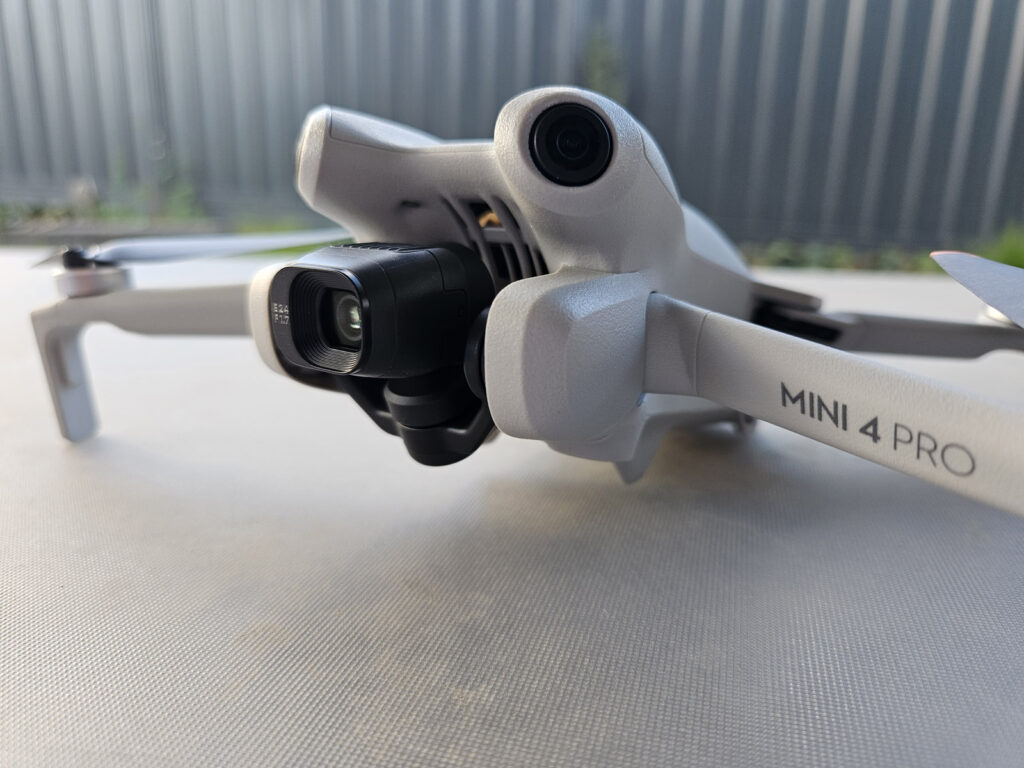
Design
DJI’s Mini 4 Pro is a very familiar, very similar drone to what we seen last year with the Mini 3 Pro, but does have a few important tweaks.
You’ll find that it still tips the scale at <249 grams, not an accident, a result of focused engineering to hit an important number.
249 grams is important for drones because it is the weight limit below which drones are exempt from many aviation regulations in many countries, including the United States, Canada, the United Kingdom, continental Europe, and Australia.
This weight limit was set by the FAA in 2015 after a committee of aviation and drone experts concluded that drones weighing less than 250 grams pose a low safety risk. Drones in this weight class are less likely to cause damage or injury in the event of a collision, and they are also more maneuverable and easier to control.
As a result of the FAA’s decision, many other countries have adopted 249 grams as the weight limit for drones that are exempt from registration and other regulations. This has made it easier for hobbyists and recreational drone users to fly their drones without having to worry about complex regulations.
The first new thing I noticed about the Mini 4 design was the change in the downward-facing sensors on the underbody of the drone, along with a LED light. While we can’t fly at night in Australia due to CASA regulations, internationally, this can help spot a landing when operating after dark.
It’s subtle, but there are also now 4 smaller vent holes below the battery compartment, rather than 2 larger ones, which I assume proved more effective in testing.
Another tweak to the design is the angle of the front and rear cameras used to detect objects and allow the drone to avoid potential impacts. With the Mini 3 Pro, the front cameras were very straight, while the Mini 4 Pro re-orients these to point outwards which provides better coverage of the world around the drone, leading to improved object avoidance performance.
The two rear-facing cameras are perhaps the largest design change on the Mini 4 Pro. Last year they were there, but were tiny, this year they’re updated to match the size and performance of the front-facing cameras. This means when making advanced shots, including moving backwards, you can have more confidence flying in reverse, avoiding poles, walls and trees. It is important to remember that no drone is perfect and you should always be cautious to protect your investment.
The key to the Mini is its portability and being the smallest drone DJI makes, this design certainly offers compact packaging that makes it easy to carry and store, and thanks to the foldable design, the legs and props can be set up and ready to fly in seconds.
The Mini 4 Pro has a sleek and aerodynamic design, with a smooth light grey finish. It seems the company has settled into this style and isn’t really interested in offering colour options. Personally, I would love to see a matte black option, similar to what Apple just rolled out with their latest laptops. There’s also probably scope for 3rd parties to provide personalisation in the form of liveries/stickers for the drone.
The back half of the drone is the battery and this can be rapidly switched out, particularly useful if you have longer or repetitive flight paths to capture. There’s a microSD card slot at the rear, along with a USB-C port to connect and download your footage, but these are a mirror of last year’s model, to the point where the batter from a Mini 3 Pro fits in the Mini 4 Pro. This will be important for those upgrading who may want to capitalise on their existing investment.
The props are the same, but the prop guard is different and while I understand the change, I’m not sure I love it. Every time I put it on, it was always an exercise in working out which orientation it needed to be as there is only one, very precise way this can be placed to fit correctly. Personally, I love what DJI did with the Mavic series, it was easy to wrap over the camera and props in seconds, so I’d love to see them move to a similar design with the Mini series. To be honest, unless you’re throwing this in a bag, you could probably get away without it.
The successful portrait/landscape lens system and attachments/filters are back which is great to see, and the drone feels very familiar to those who’ve flown DJI before, but it’s always remembering for some, that this is their first time.
The Mini 4 Pro is offered with the DJI RC 2 controller. While the basic design of the controller (thumbsticks at the top, display at the bottom) remains the same, the top of the controller now features extendable antennas. This change enables a much greater communication range between the drone and the controller, ensuring you have the ability to command it much further than regulation here (line of sight) would technically allow for.
The Mini 4 Pro is also equipped with a number of safety features, including omnidirectional obstacle avoidance and a return-to-home function. These features help to make the drone easy to fly and safe to use, even for beginners.
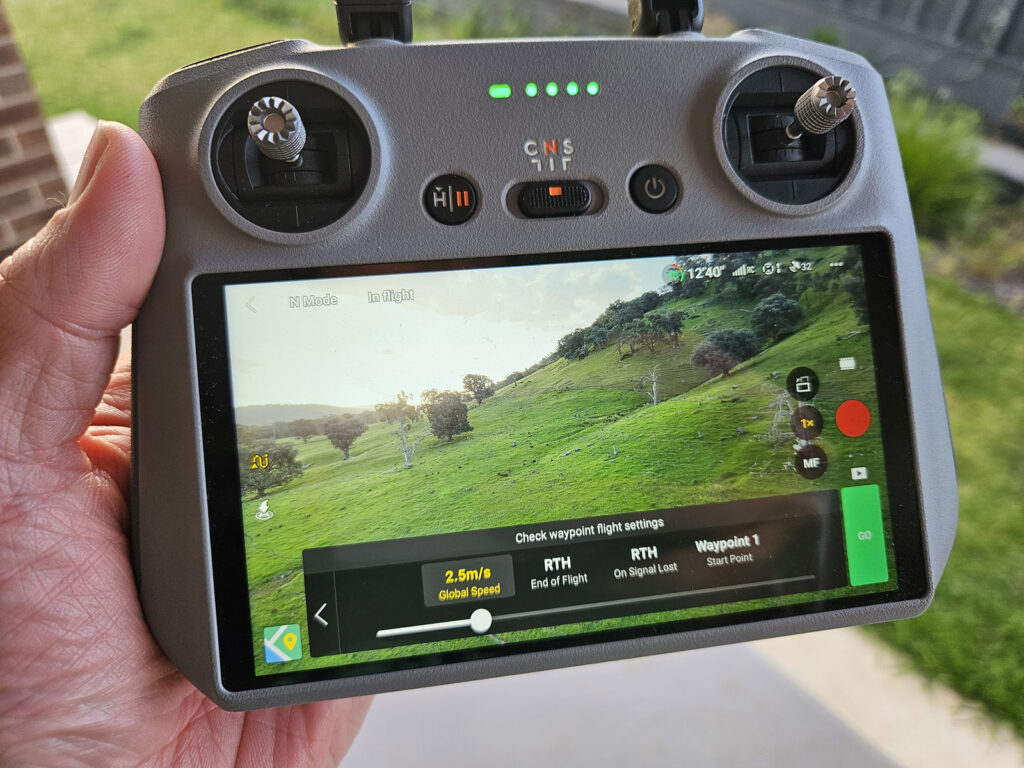

Features
DJI continues to pack a ridiculous amount of features in their drones and the Mini 4 Pro is no exception, is packed with features that make it a great choice for both beginners and experienced pilots alike.
Some of the key features include:
Omnidirectional obstacle avoidance
No drone is uncrashable, but having surround obstacle avoidance, allows you to fly your drone through complex environments, without stressing that it will be the last time you fly. In years gone by, omnidirectional obstacle avoidance was reserved for the most expensive of DJI drones and cheaper models had to deal with front-back but no sideways support, thankfully that’s now resolved.
ActiveTrack 360° with Trace Mode
It is inviting to think that everytime you want to capture something you have a friend nearby who can assist, but that’s not always the case and sometimes you’re flying solo.
This feature allows you to send the drone on a flight that pans around you, regardless of your movement, great for those who want to capture themselves, running, skating, scooting or riding.
Spotlight 2.0
This intelligent flight mode allows you to select a subject and keep the camera centered on it while you fly the drone in any direction. This makes it easy to create cinematic footage of moving subjects, even if you are not an experienced drone pilot.
To use Spotlight 2.0, simply select the mode in the DJI Fly app and then draw a box around the subject you want to track. The drone will then automatically keep the subject centered in the frame as you fly. You can adjust the altitude, distance, and orientation of the drone, but the camera will always remain locked on the subject.
Dual aspect ratio camera (16:9 and 9:16)
Being able to capture in both orientations increases the capabilities of this drone, making it great for content creators.
16:9 is the most common aspect ratio for video and is compatible with most TVs, monitors, and social media platforms. It is also the aspect ratio used for most movies and TV shows.
9:16 is a newer aspect ratio that is gaining popularity, especially on social media platforms like TikTok and Instagram Reels, YouTube Shorts and more. It is well-suited for vertical videos and photos, which are easier to view on smartphones.
Performance
There are a number of ways we can assess the performance of the DJI Mini 4 Pro, including the flight time, the speed of the drone, the quality of the footage, the collision avoidance and the range of control between the drone and the new controller.
Flight time
The DJI Mini 4 Pro has a flight time of 34 minutes with the regular battery, but if you opt for the intelligent flight battery plus, you get an impressive 45 minutes. This provides more than enough time for most aerial photography and videography tasks. I often found myself achieving my flight mission and still having lots of battery life remaining, which means there is almost no time pressure when shooting and if you mess up, you have lots of time to retry.
Speed
The DJI Mini 4 Pro has 3 different flight speeds. In the fastest Sport mode, the Mini 4 pro is capable of flying at a max speed of 16 m/s (57.6 km/hr), this drops to still a generous 12 m/s in N and C modes.
The increased speed makes the DJI Mini 4 Pro better suited for high-speed tracking shots and other dynamic aerial footage.
The Mini 4 pro can fly at wind speeds of up to 10.7 m/s. While I haven’t flown in speeds that high, I am really impressed with how stable the footage is in high winds.
Image Quality
The DJI Mini 4 Pro has a 1/1.3-inch CMOS Wide-angle camera that can capture footage in 4k/60fps with HDR. You can also film in slow motion at 100fps, still in 4K quality, which improves on the Mini 3 pro which dropped to 1080p when shooting slow motion.
Shooting with the drone isn’t all about the video, often pilots use it to capture photos of real estate, environments, and more. The Mini 4 Pro can shoot 48MP RAW photos, which means you have an amazing level of detail in the photos, if you need to adjust in post.
Collision avoidance
The DJI Mini 4 Pro has a number of collision avoidance features, including Advanced Pilot Assistance System (APAS 5.0), DJI has taken the smart tech from the Air and Mavic systems and brought them down to the Mini 4 Pro. With sensors on the front, back, and bottom of the drone that can detect obstacles and avoid them.
ActiveTrack 4.0
ActiveTrack 4.0 intelligently follows a subject while keeping it centered in the frame. This can help to avoid collisions with obstacles.
Flight Modes
Almost expected from DJI now is a wide variety of flight modes. These include Cruise Control which allows you to press a button and have the drone movement done automatically, while you control the camera angle, direction etc, almost like having two pilots.
There’s also the ability to set waypoints and simply tap record and press play, so the drone travels smoothly between the location and rotation of each waypoint, great for capturing multiple takes of the same thing.
MasterShots can help you create cinematic shots with just a few taps, automatically making a range of drone and camera moves while avoiding collisions with obstacles. This makes your drone videography look professional while being easy to capture.
There’s also the now famous QuickShots, which offers you the ability to choose individual flight sequences – Dronie, Circle, Helix, Rocket, Boomerang, and Asteroid modes which you can cut together in post.
There are also Hyperlapse modes which are basically only limited by your battery life, this works amazingly well for aerial shots where you have a cloudy sky and compress time into seconds of footage shot over multiple minutes, perfect to keep your audiences engaged.
Finally, there are the great panorama options and if you’re making desktop backgrounds, or landscape pictures for the wall, these allow you to capture multiple stills that can be assembled to capture environments much wider than even the wide-angle lens is capable of. As someone who runs 49″ ultrawide monitor, these panoramas are perfect for filling the desktop with a panorama of the sky and world below.
Advanced Return to Home
DJI’s drones will return to home for a number of reasons. Firstly you can optionally press a button on the controller to initiate the sequence which flies the drone Home which is determined as the takeoff point.
The drone will also enter RTH mode if the drone loses connection with the controller, or the battery life reaches a point where it needs to return to make it back safely.
The Mini 4 Pro can automatically plan a safe flight route back to its home point, but historically this has been almost a line-of-sight flight path. While you get to control at what altitude this RTH flight takes place, there is a chance the drone would fly into an object on the way back.
Now with Advanced RTH, the drone can bypass obstacles, facilitating more confident control during return flights.
Range of control
The DJI Mini 4 Pro has a range of up to 20 km with the new RC 2 controller. The increased range gives you more freedom to explore and capture aerial footage from a variety of locations, particularly those you can’t travel to, but can fly to. Just keep in mind the drone rules provided by CASA.
If you’re after further details, the DJI Mini 4 Pro User Manual may provide the details necessary.
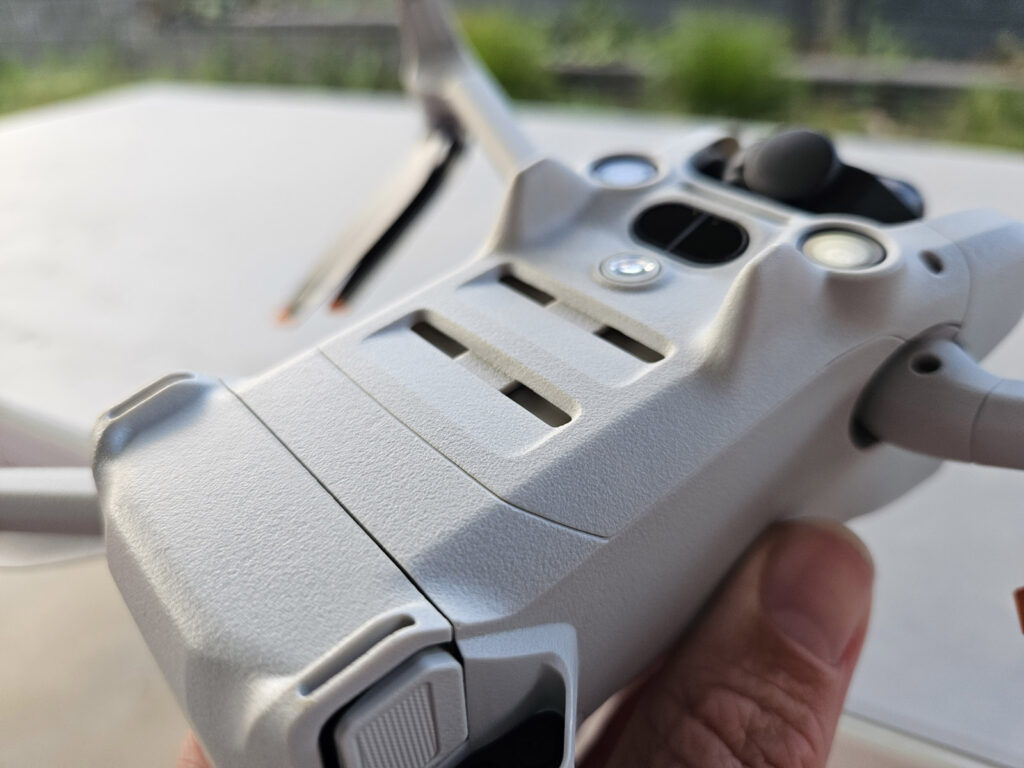

Issues
The DJI Mini 4 Pro does a great job at delivering what it reports to be. There are always impacts on the stated battery lifetime, including the video quality, temperature and wind speed. These parameters all impact battery life, but even taking those into account, the stated figures are within 5-10% of the stated numbers which is impressive.
Easily the biggest complaint people have with the Mini 4 Pro is the removal of the GPS feature this year. For those recording video for entertainment, then the GPS location won’t be important, but for those looking to use this in more professional or commercial settings, this will result in challenges with mapping footage to a location, particularly impactful for regular routes to monitor infrastructure changes.
I can’t imagine the GPS would have a significant cost to DJI, so their reasons for removing it are unclear. Perhaps there’ll be an external USB-C based GPS module that can be added back for those who need it, along with a software update to support it.
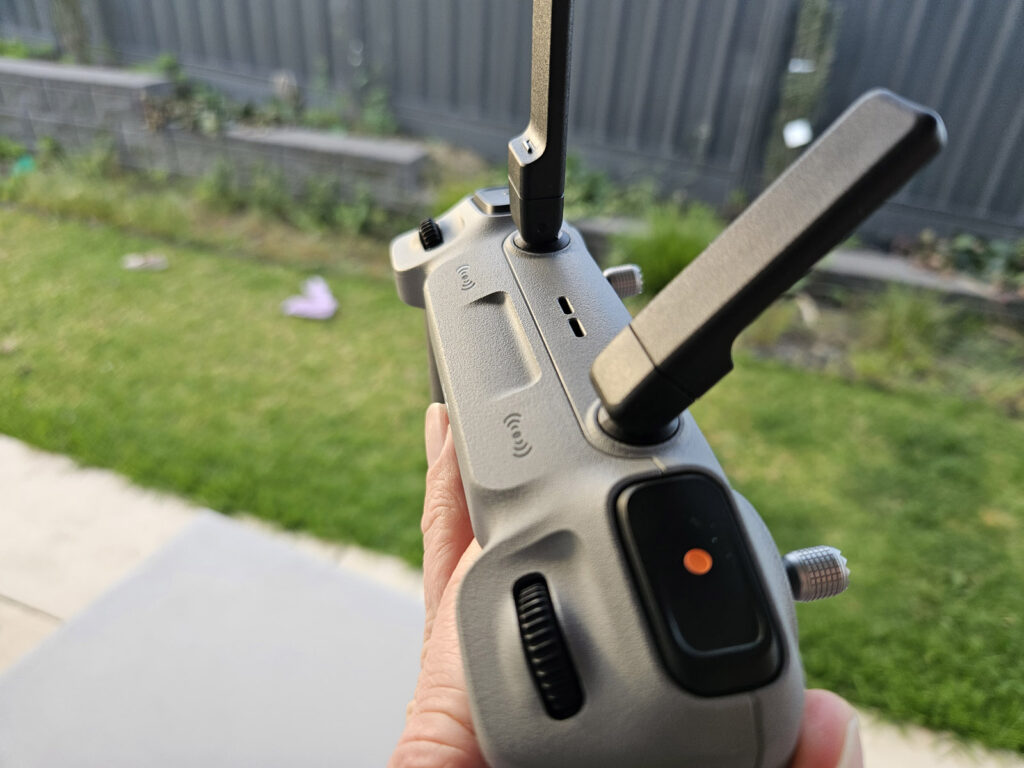

Price and Availability
You can order the DJI Mini 4 Pro now in Australia. DJI sells the Mini 4 Pro with an RC-N2 controller that is the old-style that still uses your phone. This is priced at A$1,119 but I really strongly recommend you step up to the A$1,419 bundle that offers the brilliant RC 2 controller. This avoids having to use your phone and that may not sound like a big thing, but let me tell you, it certainly is, avoiding draining your phone’s battery life while flying.
There is also a Fly More Combo kit available for A$1,699. This kit comes with the charging hub and 3x batteries, rather than 1, as well as a shoulder carry bag that can accommodate all items in the combo.
If for some reason you need a crazy level of battery life, you can step up to the most expensive option, the Mini 4 Pro Fly More Combo Plus (DJI RC 2) for A$1,799 which includes 3x Intelligent Flight Battery Plus, rather than the regular batteries.
What’s interesting about DJI’s drone offerings is that they continue to add versions to the lineup, rather than replace. This means that you as a user can make a decision on features vs price and if your budget doesn’t stretch. By comparison, the Mini 3 Pro (DJI RC) costs A$1,299 which lands $120 less than the equivalent Mini 4 Pro.. my recommendation is that you find the $120 down the back of the couch and get the latest technology.
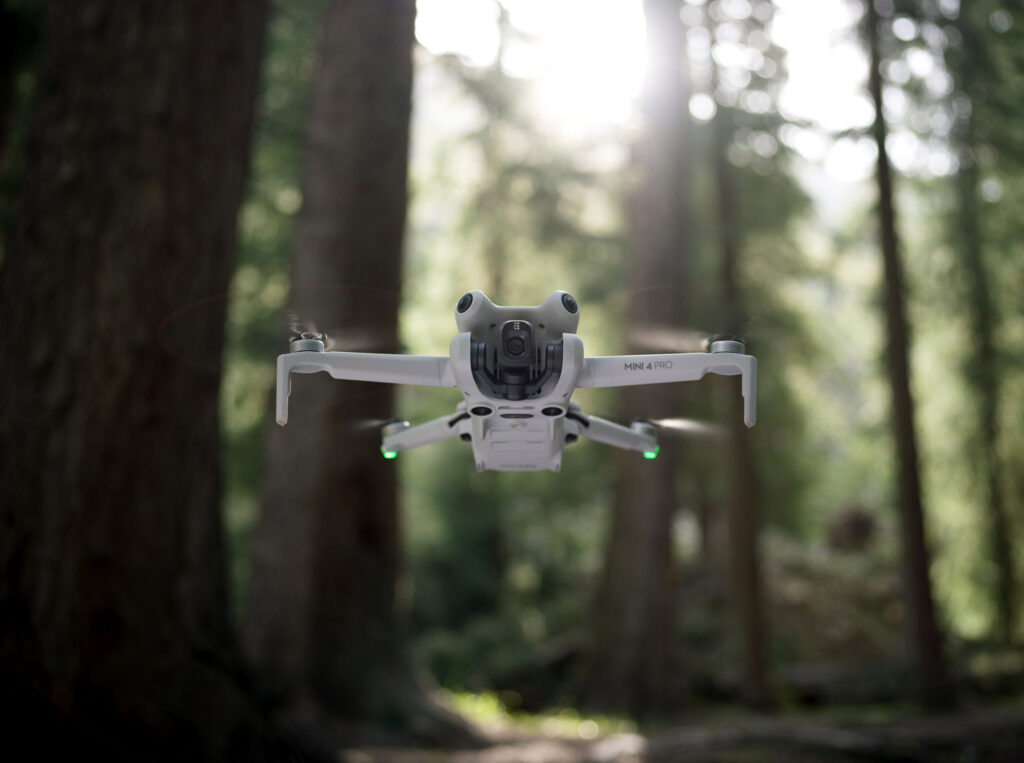

Overall
The DJI Mini 4 Pro is an excellent drone that is perfect for both beginners and experienced pilots alike.
While those buying their first drone will be tempted to spend less while establishing if they really enjoy playing pilot, I would strongly suggest they save their dollars until they can afford a drone with the features of the Mini 4 Pro.
Flying cheaper drones is actually way harder, the battery life is worse, the video quality and flight modes are also often lacking and the collision avoidance technology really helps keep your drone safe, even when you do dumb things behind the controls.
The Mini 4 Pro looks like a real incremental step forward from the Mini 3 pro, but if you consider all improvements together, there is a solid bit of R&D that has gone into improving what was a really great product last year.
The small and lightweight foldable drone means you’ll be far more likely to have it with you and ready to film, more of the time. I find that there are times when you plan out a drone shoot, travel to a destination and capture it, but there are also times when you weren’t expecting to fly, but something happens in your life, or in the environment and you’ll really wish you have the drone with you. In seconds you can be in the air and capture the action.
Overall, the DJI Mini 4 Pro is an excellent drone that offers great features, for the money and if you can find your way to the combos that offer the new RC2 controller, I’d strongly recommend it. If you want to get creative, you can pair this with DJIs motion controller, their Goggles, and throw it in FPV mode for a very different feeling (no loops and flips like the Avata though).
The big question now is, how are they going to top this next year?

Nice review, thanks.
Disappointing about GPS. Looks like I’ll have to wait some more. Presumably this may tip the weight threshold.
I would use this on the boat so RTH would need to be dynamic.